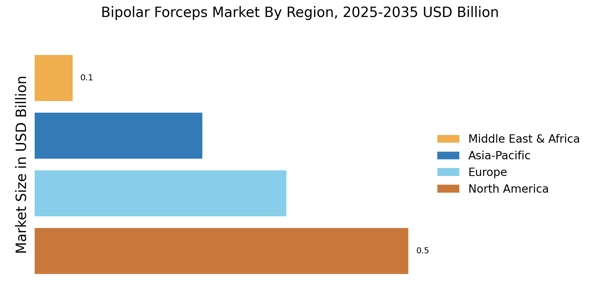Expansion of Healthcare Infrastructure
The Bipolar Forceps Market is benefiting from the expansion of healthcare infrastructure in various regions. As countries invest in improving their healthcare systems, the availability of advanced surgical instruments is increasing. This expansion is particularly evident in emerging markets, where new hospitals and surgical centers are being established to meet the growing healthcare needs of the population. The increased accessibility to modern surgical facilities is likely to drive the demand for bipolar forceps, as these instruments are essential for a wide range of surgical applications. Furthermore, the establishment of training programs for healthcare professionals in these regions is expected to enhance the adoption of bipolar forceps, thereby contributing to market growth.
Increasing Surgical Procedures Worldwide
The Bipolar Forceps Market is poised for growth due to the increasing number of surgical procedures performed worldwide. Factors such as an aging population, rising prevalence of chronic diseases, and advancements in surgical techniques contribute to this trend. For instance, the World Health Organization has indicated that surgical procedures are expected to increase by 20% in the coming years, particularly in developing regions where access to surgical care is improving. This surge in surgical activity necessitates the use of reliable and efficient surgical instruments, including bipolar forceps, which are essential for various procedures. Consequently, the demand for these instruments is likely to rise, further driving market expansion.
Technological Innovations in Bipolar Forceps
The Bipolar Forceps Market is experiencing a surge in technological innovations that enhance surgical precision and efficiency. Recent advancements include the integration of advanced materials and ergonomic designs, which improve the usability and effectiveness of these instruments. For instance, the introduction of insulated tips and improved energy delivery systems has been shown to reduce thermal spread, thereby minimizing tissue damage during procedures. According to industry reports, the market for advanced bipolar forceps is projected to grow at a compound annual growth rate of approximately 7% over the next five years. This growth is driven by the increasing adoption of these innovative tools in surgical settings, as they offer surgeons enhanced control and improved patient outcomes.
Growing Focus on Surgical Safety and Efficacy
The Bipolar Forceps Market is increasingly shaped by a growing focus on surgical safety and efficacy. Healthcare institutions are prioritizing the adoption of tools that enhance patient safety and reduce the risk of complications during surgeries. Bipolar forceps, known for their precision and control, are becoming integral to achieving these objectives. The emphasis on surgical quality is reflected in the implementation of stringent regulations and guidelines by health authorities, which encourage the use of advanced surgical instruments. As hospitals and surgical centers strive to improve patient outcomes, the demand for bipolar forceps is expected to rise, aligning with the broader trend of enhancing surgical practices.
Rising Preference for Minimally Invasive Procedures
The Bipolar Forceps Market is significantly influenced by the rising preference for minimally invasive surgical procedures. As healthcare providers and patients alike seek alternatives to traditional open surgeries, the demand for instruments that facilitate such procedures has escalated. Bipolar forceps are particularly favored for their ability to provide precise coagulation and cutting capabilities with minimal incisions. This trend is reflected in the increasing number of laparoscopic surgeries performed annually, which has been reported to rise by over 10% in recent years. The shift towards minimally invasive techniques not only enhances patient recovery times but also reduces overall healthcare costs, thereby propelling the growth of the bipolar forceps market.


















Leave a Comment